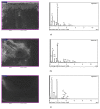Influence of Sandblasting and Chemical Etching on Titanium 99.2-Dental Porcelain Bond Strength
- PMID: 35009263
- PMCID: PMC8746101
- DOI: 10.3390/ma15010116
Influence of Sandblasting and Chemical Etching on Titanium 99.2-Dental Porcelain Bond Strength
Abstract
The metal-ceramic interface requires proper surface preparation of both metal and ceramic substrates. This process is complicated by the differences in chemical bonds and physicochemical properties that characterise the two materials. However, adequate bond strength at the interface and phase composition of the titanium-bioceramics system is essential for the durability of dental implants and improving the substrates' functional properties. In this paper, the authors present the results of a study determining the effect of mechanical and chemical surface treatment (sandblasting and etching) on the strength and quality of the titanium-low-fusing dental porcelain bond. To evaluate the strength of the metal-ceramic interface, the authors performed mechanical tests (three-point bending) according to EN ISO 9693 standard, microscopic observations (SEM-EDS), and Raman spectroscopy studies. The results showed that depending on the chemical etching medium used, different bond strength values and failure mechanisms of the metal-ceramic system were observed. The analyzed samples met the requirements of EN ISO 9693 for metal-ceramic systems and received strength values above 25 MPa. Higher joint strength was obtained for the samples after sandblasting and chemical etching compared to the samples subjected only to sandblasting.
Keywords: bond strength; dental porcelain; metal-ceramic system; surface treatment; titanium 99.2.
Conflict of interest statement
The authors declare no conflict of interest.
Figures







Similar articles
-
Influence of surface airborne-particle abrasion and bonding agent application on porcelain bonding to titanium dental alloys fabricated by milling and by selective laser melting.J Prosthet Dent. 2020 Mar;123(3):491-499. doi: 10.1016/j.prosdent.2019.02.011. Epub 2019 Jul 12. J Prosthet Dent. 2020. PMID: 31307799
-
The effects of laser etching on shear bond strength at the titanium ceramic interface.J Prosthet Dent. 2009 Feb;101(2):101-6. doi: 10.1016/S0022-3913(09)60002-0. J Prosthet Dent. 2009. PMID: 19167534
-
Effect of surface treatment on bond strength of low-fusing porcelain to commercially pure titanium.J Prosthet Dent. 2005 Oct;94(4):350-6. doi: 10.1016/j.prosdent.2005.07.007. J Prosthet Dent. 2005. PMID: 16198172
-
Metal-ceramic bond: how to improve?Minerva Stomatol. 2009 Jul-Aug;58(7-8):367-73. Minerva Stomatol. 2009. PMID: 19633637 Review.
-
Metal Marking Behavior and Testing of Porcelain Tableware.Materials (Basel). 2022 Mar 25;15(7):2442. doi: 10.3390/ma15072442. Materials (Basel). 2022. PMID: 35407775 Free PMC article. Review.
Cited by
-
Effect of Sandblasting Parameters and the Type and Hardness of the Material on the Number of Embedded Al2O3 Grains.Materials (Basel). 2023 Jul 2;16(13):4783. doi: 10.3390/ma16134783. Materials (Basel). 2023. PMID: 37445098 Free PMC article.
References
-
- Knosp H., Holliday R.J., Corti C.W. Gold in dentistry: Alloys, uses and performance. Gold Bull. 2003;36:93–102. doi: 10.1007/BF03215496. - DOI
LinkOut - more resources
Full Text Sources
Research Materials
Miscellaneous

